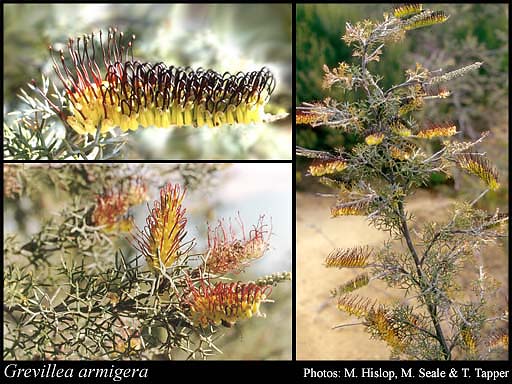- Reference
- A.DC., Prodr. 14:373 (1856)
- Conservation Code
- Not threatened
- Naturalised Status
- Native to Western Australia
- Name Status
- Current
Prickly, erect to spreading, non-lignotuberous shrub, (0.6-)1-3.6 m high. Fl. green/green & yellow & black & red, Jan to Feb or Jun to Dec. Yellow or white sand, gravelly soils, sandy clay.







Scientific Description
Shrubs, 1-2 m high; branchlets hairy, not glaucous. Leaves alternate, 20-30 mm long, hairy, on the abaxial surface, the hairs straight; lamina flat, twice or more divided, pinnately divided, divided to the midrib; lobes 8-15 mm long, 0.5-1.5 mm wide, the margins revolute, enclosing the lower surface of the leaf blade, forming a groove either side of the midvein. Inflorescences terminal, green, yellow or grey; pedicels 1-2 mm long. Perianth 8-9 mm long; tepals all free after flower opens, hairy, simple-hairy; ovary hairy, sessile; pistil 16-20 mm long, purple or black, pollen presenter oblique, style glabrous. Follicles hairy, not viscid, dehiscent, 12-14 mm long. Flowers in January, February, June, July, August, September, October, November or December. Occurs in the South-west (SW) Botanical Province(s), in the Geraldton Sandplains (GS) or Avon Wheatbelt (AW) IBRA subregion(s).
Distribution
- IBRA Regions
- Avon Wheatbelt, Geraldton Sandplains.
- IBRA Subregions
- Katanning, Lesueur Sandplain, Merredin.
- Local Government Areas (LGAs)
- Dalwallinu, Goomalling, Koorda, Moora, Wongan-Ballidu.